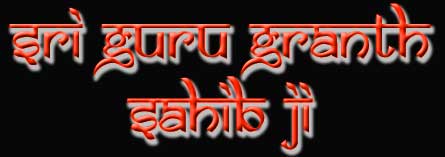
Sri Guru granth Sahib Ji is the holy book of the Sikhs - a scripture that takes its place alongside the world's greatest scriptures: the Vedas, the Bible, the Quran and the Zend Avesta. The first edition of the Adi Granth was scribed by Bhai Gurdas on the dictation of Guru Arjan. He developed it from a Bani Pothi - a nucleus of the writings of the first four Gurus and some bhagats by adding a considerable material of his own. It was completed in 1661 BS (AD 1604) and was formally installed in the Golden Temple in the same year. Baba Buddha was appointed the first granthi. The second edition was transcribed by Bhai Banno and the third and the last edition was prepared by Bhai Mani Singh under the supervision of Guru Gobind Singh in 1762-63 BS (AD 1705). The final version which is the authorized version in use at present includes the hymns of Guru Tegh Bahadur as well. (This is called the damdami bir - it is a disputable subject as some chroniclers believe that Guru Ji never dictated any Bir to Bhai Mani Singh )
Adi Granth is a collection of devotional hymns and prayers to the Supreme. It throws light on the path leading to the highest goal of spirituality. In it philosophy is propounded to the songs of love and devotion. The message of love, truth, contentment, humility, fatherhood of God, brotherhood of man, restraint of passions, mercy on living beings, purity of mind and body, search for the self and Higher Soul, equality of man and woman, service, liberalism in the matter of food and clothing constitute the main contents of the Adi Granth.
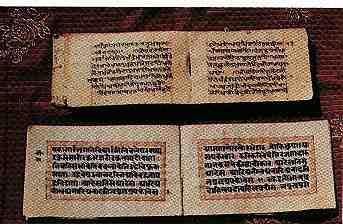
Bhagat banis in Sri Guru Granth Sahib
Besides the seven Sikh Gurus, the Adi Granth has in it also the compositions of bhagats or saints and bhatts or bards. Basic facts about the bhagats are given in the Table below.
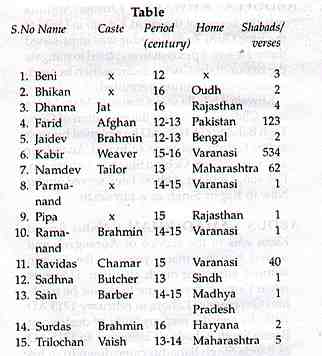
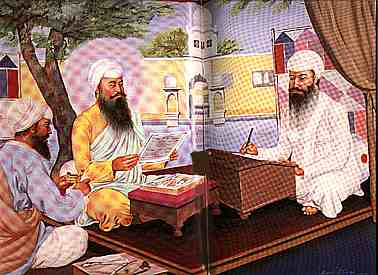
Contributors of the Banis
TheAdi Granth is the only scripture of the kind which contains within its sacred covers the songs and utterances of a wide variety of saints, savants and bards. There are compositions of seven Sikh Gurus, and other saints who had their origin as high born Brahmins, proud Kshatriyas, lowly Sudras and unlettered Jats. The number of Shabads and other compositions contributed by them is as follows:
1. Guru Nanak 947 2. Guru Angad 63 3.Guru Amardas 869 4.Guru Ramdas 638 5.GuruArjan 2312 6.GuruTeghBahadur 115 7.Guru Gobind Singh 1 8.Kabir 534 9.Farid 123 10.Namdev 62 11.Ravidas 40 12.Trilochan 5 13.Beni 3 14.Dhanna 4 15.Jaidev 2 16.Bhikhan 2 17.Sain 1 18.Pipa 1 19.Sadhna 1 20.Ramanand 1 21.Parmanand 1 22.Surdas 2 23.Sunder 6 24.Mardana 3 25.Satta 8 26.Bhatts 123
Although Guru Gobind Singh did not include his writings in the Adi Granth, one sloka: Bal hoa bandhan chhute... on page 1429 is sometimes attributed to him. The copy of the Adi ranth kept at Takhat Patna Sahib mentions Mahala Ten (Tenth Master) against it.
THE LANGUAGE of the Guru Granth Sahib:
The Adi Granth represents devotional poetry of the highest order. It is written in Gurmukhi script. The language principally employed is the language of the saints, evolved during the medieval period. It is a language, which allowing for variations, enjoyed wide currency in Northern India during the days of Bhakti Movement. Its appeal lay in its directness, energy and resilience. This Sant bhasha contains words not only from Sanskrit, Prakrit and Apabhramsha but also from Persian and Arabic. Besides Sant bhasha we find writings in the Adi Granth in Eastern Punjabi and Western Punjabi (Lehndi). For example Baba Farid, Satta and Balvand are essentially poets of Western Punjabi but Guru Nanak and Guru Arjan have also written some hymns in that dialect in addition toother dialects.
ORGANISATION AND RAAGS :
The complete musicalization of thought in the Adi Granth in a scientific and studied manner is its important distinguishing feature. The printed version, which in its current form comes to 1430 pages is divided into 33 sections. Whilst the first section comprises the soulful and inspiring song of Guru Nanak called Japji and also a few selected Paudis, the final section is a collection of assorted verses including the slokas and the swayyas of bhatts. The remaining 31 sections are named after the well-known classical raags and are supposed to be sung in those raags. These are: 1. Sri raag 2. Majh 3. Gauri 4. Asa 5. Gujari 6. Devgandhari 7.Bihagra 8. Wadhans 9. Sorath 10, Dhanasari 11.Jaitsari 12. Todi 13. Bairari 14. Tilang 15.Suhi 16. Bilawal 17. Gaund 18. Ramkali 19.Nat 20. Maligaura 21. Maru 22. Tukhari 23.Kedara 24. Bhairo 25. Basant 26. Sarang 27.Malar 28. Kanara 29. Kalian 30. Prabhati 31.Jaijawanti.
The order of hymns under each raag is generally as follows : Shabads, Ashtpadis, Chhand, Var and hymns contributed by the bhaktas. The shabads of Guru Nanak are given first and are followed by those of other Gurus in chronological order. The Gurus are referred to as Mahalas in the text, thus Mahala 1 meaning Guru Nanak. Generally there is an indication regarding the main tune-ghar-to be used in the singing of the shabad If no ghar is indi cated, the shabad should be sung in pure form.
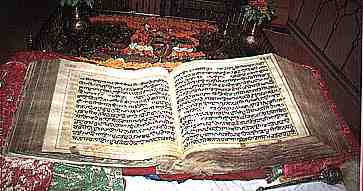
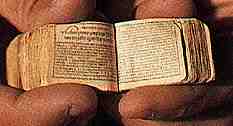
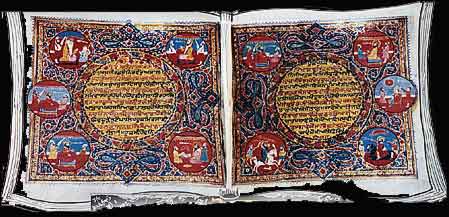
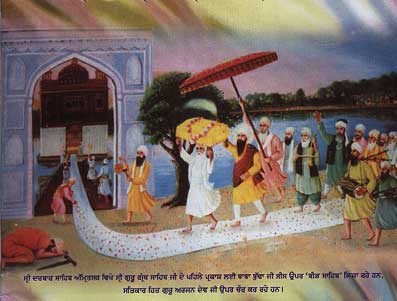

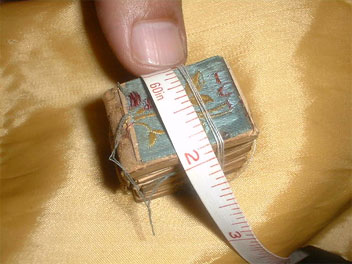
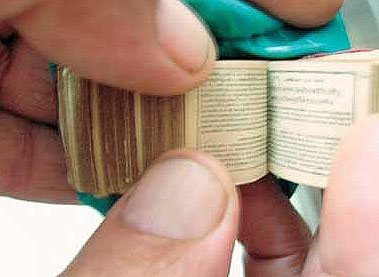
Only four or maybe five copies of the book, that was commissioned by the Lion of Punjab, Maharaja Ranjit Singh, who ruled Punjab during what is called its golden age between 1801 and 1839 AD, are known to exist. One of them is owned by an electronics shopkeeper in Chembur, also called Ranjit Singh.
As Sikhs world-wide celebrate the 400th anniversary of the installation of the Guru Granth Sahib at the Golden Temple in Amritsar, Singh's copy of the holy book has attracted a lot of attention from the Sikh community.
"One copy has been kept in the museum attached to the Golden temple. There is no information on the two other copies," says Puran Singh, general secretary of the Guru Nanak Darbar gurudwara in Chembur.
The pages of the tiny book (it can be held in a folded fist and is just 1 inch x 1.5 inch in dimension) have faded to a pale yellow and its binding has come lose. But the print that has to be read using a magnifying is still sharp.
Ranjit Singh, an electronics shop owner in Chembur, who owns the miniature Singh, however, is reluctant to send the fragile book outside his house in Chembur Camp to get it rebound. "It is too invaluable to be sent outside," he said.
Though the book is a miniature, it contains the exact number of pages, 1,430, as in a regular-sized Guru Granth. Singh says that the book has been in the possession of his family since his grandfather Sundar Singh's time.
The book is taken out only on special days like Guru Purab or the birthday of the Guru. "Some times relatives from abroad come to have a look at it," says Singh.
Courtesy Inderpal Singh
THE ABOVE MINIATURE GURU GRANTH SAHIB IS FOR SALE - ANYBODY INTERESTED PLEASE GET IN TOUCH WITH THE OWNER-INDERPAL SINGH ON:-Email: ipsingh@hotmail.com
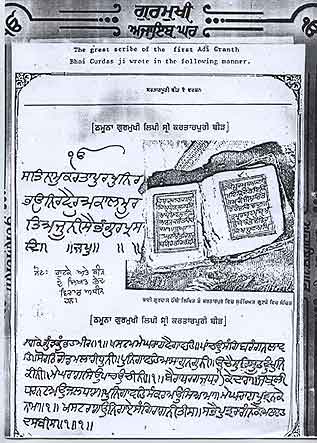
Writing of the Kartarpuri Bir by Bhai Gurdas
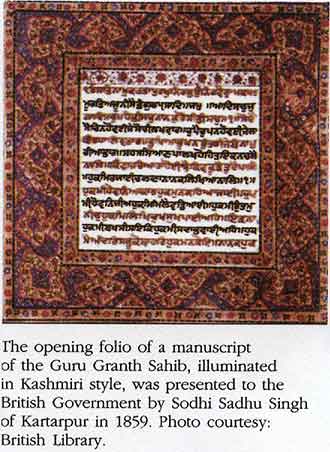
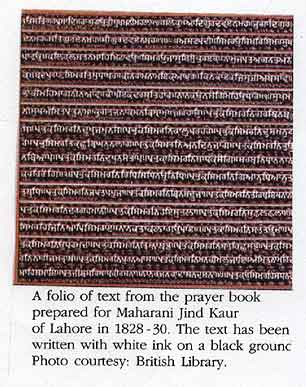
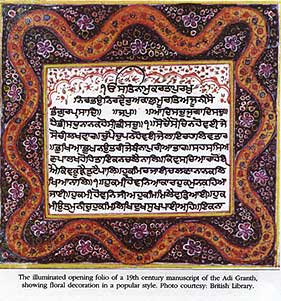
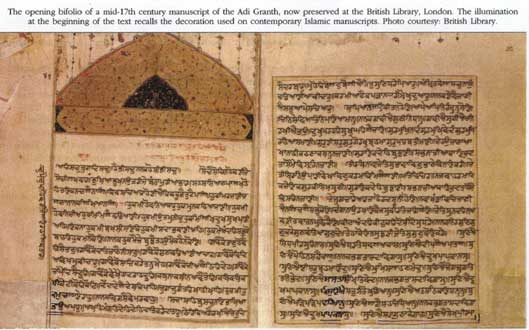
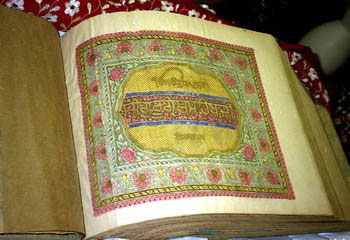
A beautiful manuscript of Guru Granth Sahib
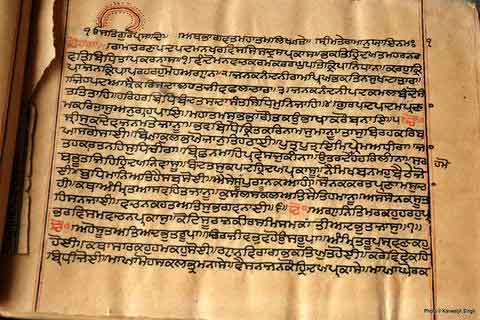
Manuscripted Bhagwat Puran (courtesy - Prof. Balwinder Singh)
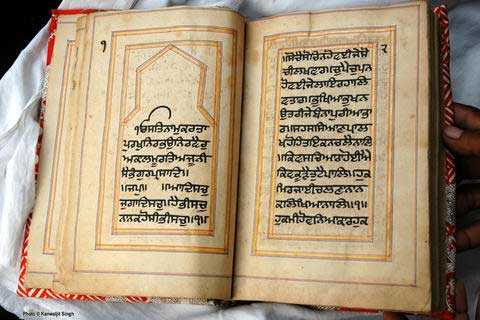
A manuscripted Panj Granthi (courtesy - Prof. Balwinder Singh)
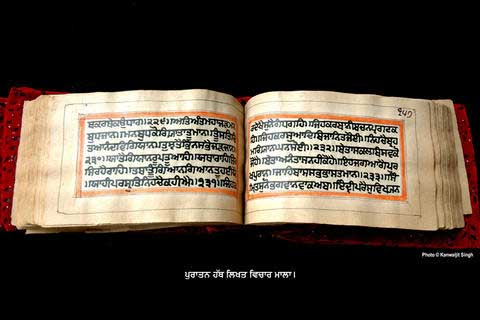
Manuscripted Vicharmala (courtesy - Prof. Balwinder Singh)
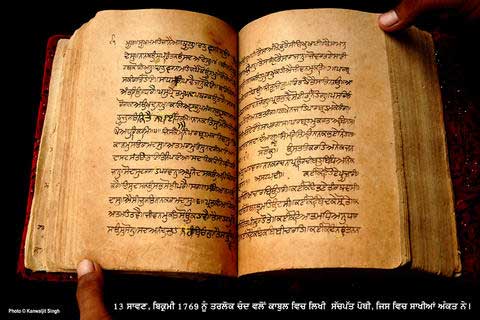
Manuscripted Sachpath pothi (courtesy - Prof. Balwinder Singh)
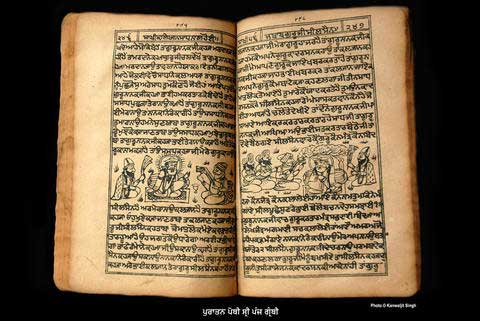
A stone printed Panj Granthi(courtesy - Prof. Balwinder Singh)
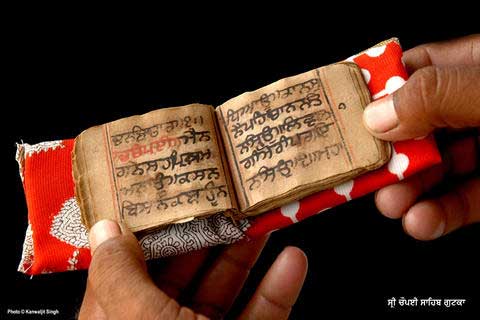
A miniature handwritten Gutka (courtesy - Prof. Balwinder Singh)
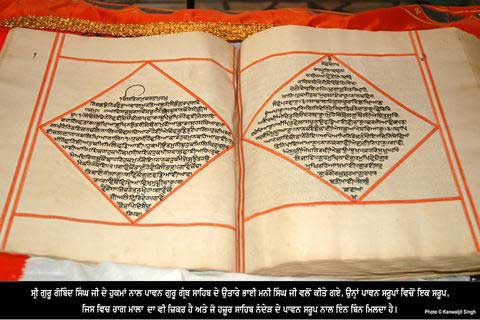
A Manuscript of an early Guru Granth Sahib(courtesy - Prof. Balwinder Singh)
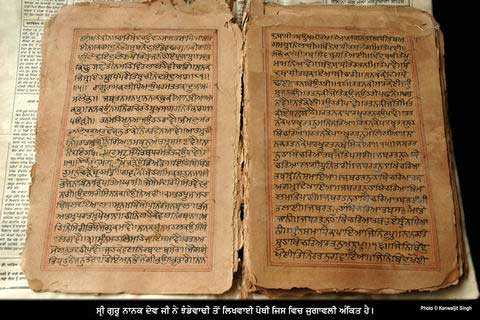
A pothi dictated by Guru Nanak and written by Bhai Jhanda Badhi containing the 'Jugawali' (courtesy - Prof. Balwinder Singh)
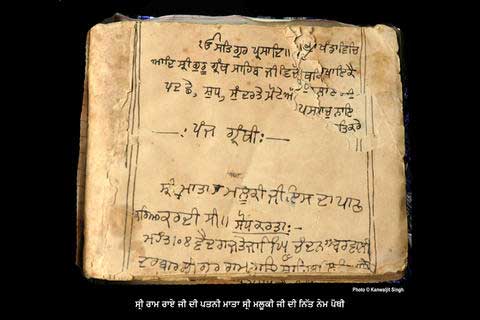
A hand written Panj Granthi belonging to Mata Sri Malooki Ji wife of Baba Ram Rai (courtesy - Prof. Balwinder Singh)
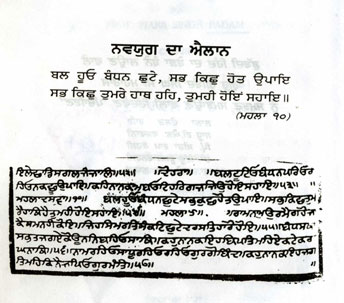
This saloka is attributed to Guru Gobind Singh Ji (mahalla 10). The modern 'birs' do not have this but some of the old manuscripts, like the above, clearly assigns this saloka to Guru Gobind Singh Ji. (taken from the book by P.S.Padam, 'Gobind Sagar')
AARTI
Appreciation of Arti!!
> Once actor Balraj Sahni asked the late Nobel Laureate Rabindra Nath Tagore,
> "You have written the national anthem for India. Can you write an
> international anthem for the whole world?" "It has already been written, not
> only international but for the entire universe, in the 16th century by Guru
> Nanak," replied Tagore. He referred to the Sikh arti (ceremony of light).
> Gurudev Tagore was so enamoured of this arti that he personally translated
> it into Bengali.
>
> Every evening in all Gurudwaras, after the recitation of Rehraas Sahib, we
> can hear a melodious rendition of the arti sung by the Raagis in Raga
> Dhanashri. This is a tremendously soothing experience, capable of taking us
> directly into the spiritual realms of devotion through music.
>
> As Guru Arjan Dev has written on page 393 of Sri Guru Granth Sahib Ji - arti
> kirtan sada anand. Singing God's praises is His arti, bringing boundless
> bliss.
>
> As legend has it, in 1508 Guru Nanak Dev visited the famous temple of
> Jagannath at Puri in Orrisa, which was very well known for its arti for Lord
> Krishna. In the evening, priests brought a platter full of many lighted
> lamps, flowers, incense and pearls and began the arti. Guru Nanak Sahib
> meanwhile spontaneously gave words to the wonderful arti which was being
> hummed by Nature before the invisible altar of God, the creator of this
> universe:
>
> Gagan mein thaal rav chand dipak bane, tarika mandal janak moti, dhoop
> malyanlo pavan chavro kare saal banray phulant joti, kaisi arti hoye bhav
> khandna teri arti. (Sri Guru Granth Sahib Ji, page 663)
>
>
> The sky is puja thaal (platter used for the artis), in which sun and moon
> are the diyas (lamps)/ The stars in the constellations are the jewels/ The
> wind, laden with sandal-wood fragrance, is the celestial fans/ All the
> flowering fields, forests are radiance! What wonderful worship this is, oh!
> Destroyer of fear, THIS is your arti!
>
> However, the arti that is sung daily in the Gurudwaras is however only
> partly composed by Guru Nanak Dev Ji. The second stanza, from "Naam tero
> arti majan muraare Hark e Naam bin jhoothey sagal pasaarey" - SGGSJ page 695
> (O Lord, Thy name to me is the arti and holy ablutions. Everything else is
> false, onward has been composed by Bhagat Ravi Das, who, incidentally, was a
> cobbler.
>
> The third stanza, "Dhoop deep ghrit saaji arti vaarne jaau kamalapati" (May
> I be a sacrifice unto the Lord: that for me is the arti performed with
> lamps, ghee and incense' (SGGSJ: page 695) onwards, was composed by Sant
> Sain, a barber in the court of Raja Ram, King of Rewa.
>
> The fourth stanza, from "Sun sandha teri dev devaakar adhpat aad samaayi",
> 'Brothers! That is how the Immaculate Lord's arti is made: Let Divine
> essence be the oil, the Lord's Name the wick and the enlightened self, the
> lamp. By lighting this lamp we invoke the Lord' (Sri Guru Granth Sahib Ji:
> page
> 1350) onwards, was composed in the same vein by Sant Kabir, the Muslim
> Julaha (The Weaver).
>
> Thereafter, from "Gopal tera arta jo jan tumhri bhagat karante tin ke kaaj
> sanvaarta", 'O Gopala, accept your arti! You grant the wishes of those who
> worship you! (Sri Guru Granth Sahib Ji: page 695) onwards, was composed by
> Bhagat Dhanna, a simple Jat farmer from Rajasthan.
>
> The final part was composed by Guru Gobind Singh Ji, right from Ya te. maha
> mun devar ke tap mein sukh pave jag kare ik ved rarey". The Lord is pleased
> by penance, prayers, rituals, recitation of scriptures, meditation music and
> dance of celestial beings and the melody of the arti. The cosmic worlds
> rejoice and chant the Divine Name onwards.
>
>
>
> That the arti which we sing daily has been composed by two Gurus, a cobbler,
> a barber, a weaver and a farmer is yet more proof that Sikhism believes in
> the equality of all human being:
>
> Awal Allah noor upaya/ Kudrat ke sab bandey/ Ek noor te sab jag upjaya/ Kaun
> bhale ko mande.
>
> 'First of all, God created light; Mother Nature created all human beings
> equal; from that one Light the entire world came into being; so how do we
> differentiate that one is better that the other?'
>
>
>
> Jo tis bhave so arti hoye (That which pleases Him is true worship)